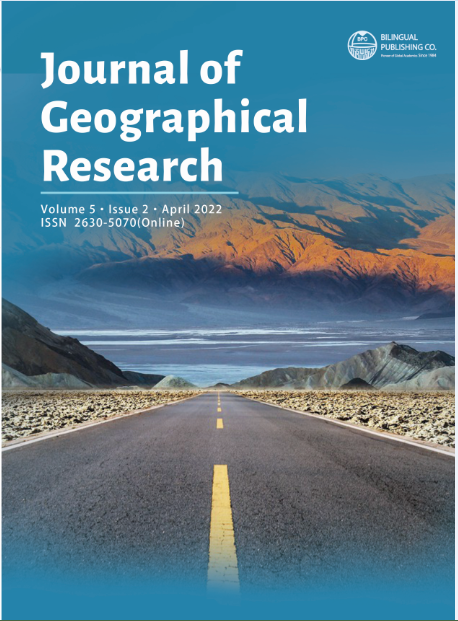-
11458
-
1935
-
1847
-
1712
-
1393
Assessment of Stakeholders’ Perceptions of Landuse/Landcover Change Drivers in Abuja, Nigeria
DOI:
https://doi.org/10.30564/jgr.v5i2.4273Abstract
Landuse/Landcover (LULC) changes are recognised as some of the major causes of environmental problems like land degradation and climate change. To achieve sustainability, we need to properly understand such changes in order to have adequate information that will enable us to design and implementing measures to mitigate their negative impacts. Doing this particularly requires a proper understanding of how stakeholders perceive the changes in general and their drivers in particular. Unfortunately,not much is known for many areas about the perspective of landuse stakeholders on drivers of LULC changes. This paper reports the results of a study conducted to examine the perceptions of different landuse stakeholders on drivers of LULC changes in Abuja Federal Capital Territory, Nigeria.Questionnaire survey was utilised, involving 514 households across four settlements, 2 rural (Karshi and Orozo) and 2 urban (Nyanya and Karu) towns in the territory, which were complimented with Focus Group Discussions were conducted. The results obtained showed that urban dwellers are largely aware of drivers of changes in socioeconomic drivers (physical development on lands, more commercial complex development and more institutional development). Rural dwellers are largely aware of environmental drivers of LULC changes (bush burning, livestock overgrazing, collections of wood and medicinal plants,and agricultural expansion). It was concluded that there is the need to bring about a harmonisation of the perceptions of LULC change drivers by the rural and urban dwellers so as to bring about a common front understanding and responding to LULC changes in the study area.
Keywords:
Landuse, Landcover, Change, Drivers, Stakeholders, Rural, UrbanReferences
[1] Lambin, E.F., Geist, H., Lepers, E., 2003. Dynamics of land use and cover change in tropical regions. Annual Review of Environment and Resources. 28, 205-241.
[2] Turner, B.L, Skole, D., Sanderson, S., et al., 1995.Land use and Land-cover Change.Science/Research Planning, IGBP Report No. 35.
[3] Mashi, S.A., Shuaibu, H.S., 2018. People and sus-tainable land management: assessment of stakeholders’ knowledge of the nature of landuse/cover change in Abuja, Nigeria. GeoJournal. 83(3), 545-562.DOI: https://doi.org/10.1007/s10708-017-9782-y
[4] Kates, R.W., Haarmann, V., 1992. Where the poor live: Are the assumptions correct? Environment.34(4), 4-28.
[5] Lambin, E., Geist, H., 2007. Causes of land-use and land-cover change. Retrieved from http://www.eoearth.org/view/article/150964.
[6] Leemans, R., Lambin, E.F., McCalla, A., et al., 2003.Drivers of change in ecosystems and their services.In Ecosystems and Human Well-Being: A Framework for Assessment, ed. H. Mooney, A. Cropper, W. Reid.Washington, DC: Island Press. ISBN: 1559634030.
[7] Meshesha, D., Tsunekawa, A., Tsubo, M., 2012a.Continued land degradation: cause-effect in Ethiopia’s CRV. Land Degradation Development. 23, 130-143.
[8] Balogun, O., 2001. Abuja: Geography of its Development. Ibadan, Nigeria, University Press Ltd.
[9] Angelsen, A., Kaimowitz, D., 2001. Agricultural Technologies and Tropical Deforestation.Wallingford, UK: CABI Publishing. pp. 440.
[10] Enedah, I.C., Igbokwe, J.I., Ojiako, J.C., et al., 2015.Spatio-temporal analysis and mapping of urban development trends in the Federal Capital City (FCC) Abuja, Nigeria from 1990 to 2014. International Journal of Scientific Research and Engineering Studies. 2(9), 36-39.
[11] Kessides, C., 2005. The Urban Transition in Sub-Saharan Africa: Implications for Economic Growth and Poverty Reduction. Africa Region Working Paper Series no. 97. New York: The World Bank.
[12] Richardson, H.W., 2005. Polarization Reversal in Developing Countries. Papers in Regional Science.45(1), 67-85.
[13] Meshesha, D., Tsunekawa, A., Tsubo, M., 2012b.Dynamics and hotspots of soil erosion and management scenarios of the Central Rift Valley of Ethiopia.International Journal of Sediment Research. 27, 84-99.
[14] Mengistu, D.A., Waktola, D.K., Woldetsadik, M.,2012. Detection and analysis of land-use and land cover changes in the midwest escarpment of the Ethiopian Rift Valley. Journal of Landuse Land cover Science. 7(3), 239-260.
[15] Ariti, A.T., van Vliet, J., Verburg, P.H., 2015. Landuse and land-cover changes in the Central Rift Valley of Ethiopia: Assessment of perception and adaptation of stakeholders. Applied Geography. 65, 28-37.
[16] Molla, M., 2014. Land use/land cover dynamics in the CRV Region of Ethiopia: the case of Arsi Negele District. Academy Journal of Environment Science.2(5), 74-88.
[17] López-Carr, D., Ryan, S.J., Clark, M.L., 2022.Global Economic and Diet Transitions Drive Latin American and Caribbean Forest Change during the First Decade of the Century: A Multi-Scale Analysis of Socioeconomic, Demographic, and Environmental Drivers of Local Forest Cover Change. Land. 11(3),326.DOI: https://doi.org/10.3390/land11030326
[18] Lambin, E.F., Turner, B.L., Geist, H., et al., 2001.The causes of land-use and land-cover change:moving beyond the myths. Global Environmental Change. 11(4), 261-269.
[19] Geist, H.J., Lambin, E.F., 2002. Proximate causes and underlying driving forces of tropical deforestation. BioScience. 52(2), 143-150.
[20] Contreras-Hermosilla, A., 2000. The underlying causes of forest decline. CIFOR Occasional Paper 30, Center for International Forestry Research, Bogor, Indonesia.
[21] Fan, F., Weng, Q., Wang, Y., 2007. Landuse and Landcover Change in Guangzhou, China, from 1998-2003, Based on Landsat TM/ETM+ Imagery. Sensors. 7, 1323-1342.
[22] Aroengbinanga, B.W., Kaswantoa, A., 2015. Driving force analysis of landuse and cover changes in Cimandiri and Cibuni Watersheds. Procedia Environmental Sciences. 24, 184-188.
[23] Geist, H.J., Lambin, E.F., 2004. Dynamic causal patterns of desertification. BioScience. 54(9), 817-829.
[24] Kaswanto, N.N., Arifin, H.S., 2010. Impact of Land Use Changes on Spatial pattern of landscape during two decades (1989-2009) in West Java region. HIKOBIA. 15, 363-376.
[25] Angelsen, A., Kaimowitz, D., 1999. Rethinking the causes of deforestation: lessons from economic modesls. World Bank Research Observer. 14(1),73-98.
[26] Crosthwaite, J.J., Callaghan, Q., Farmer-Bowers, C.,et al., 2004. Land use changes, their drivers and impacts on native biodiversity. Department of sustainability and environment, Victoria, USA. Hillel D.
Downloads
How to Cite
Issue
Article Type
License
Copyright © 2022 Sani Abubakar Mashi, Amina Ibrahim Inkani, Safirat Sani, Hassana Shuaibu

This is an open access article under the Creative Commons Attribution-NonCommercial 4.0 International (CC BY-NC 4.0) License.




 Sani Abubakar Mashi
Sani Abubakar Mashi





